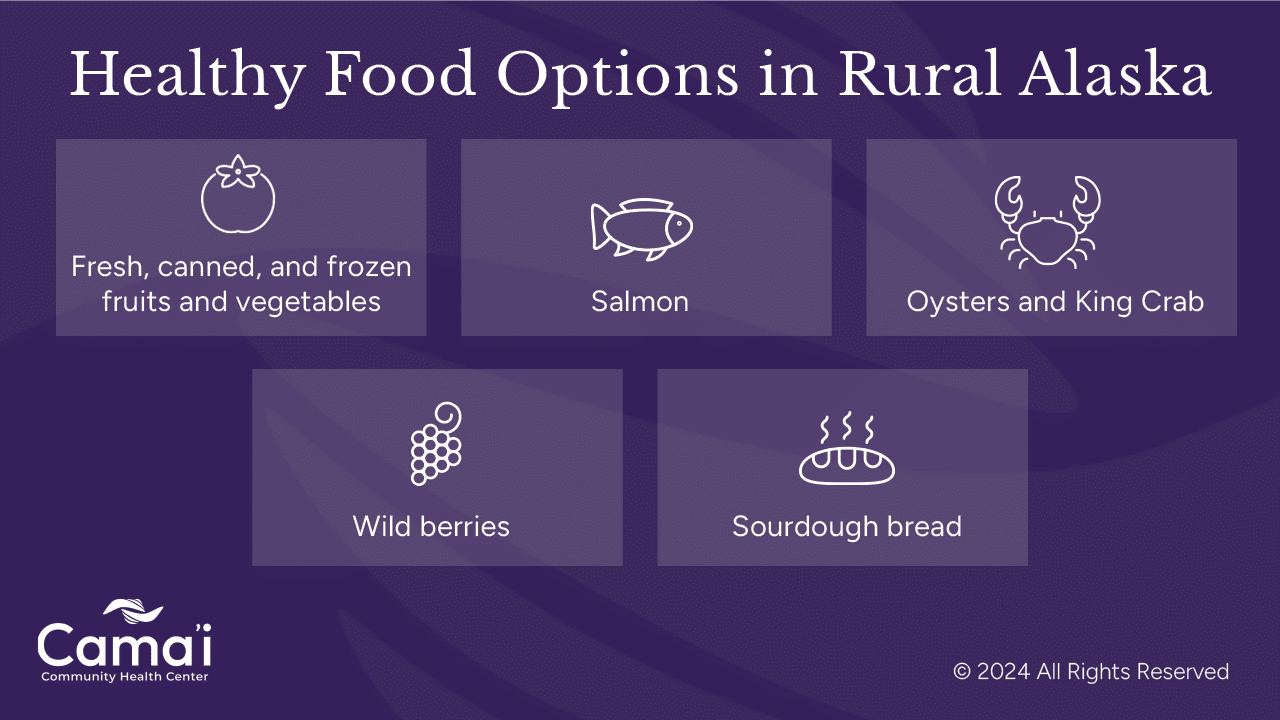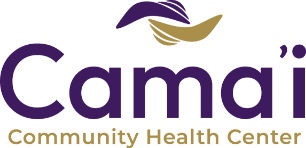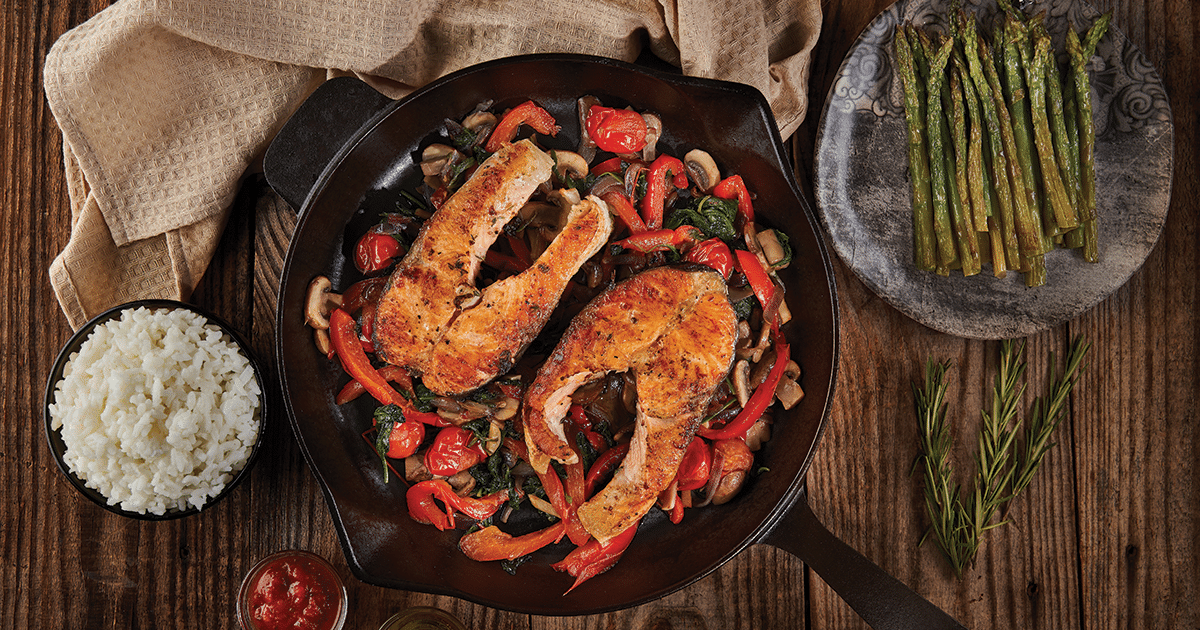Alaskans face several challenges when trying to follow a healthy diet. A large percentage of foods are imported, with very long supply chains that contribute to food insecurity. Because of the relatively short growing season in this state, fresh produce isn’t always as easily available as it is in the lower 48 states. In addition, some of the traditional foods that Alaskans love aren’t the healthiest choices for everyday eating. On the other hand, many local foods are exceptionally healthy. Here’s a look at the nutritional challenges and how to choose foods that fit in well with a healthy diet in Alaska.
Schedule an appointment with our dietician today for guidance on eating well in rural Alaska!
Food Insecurity in Rural Alaska
Food insecurity is such a problem in rural Alaska that, according to the Food Bank of Alaska, about 100,000 Alaskans face the prospect of hunger. Food insecurity happens when there is not enough affordable, nutritious food for everyone to have a healthy diet. Weather events and semi-accidents on treacherous roads often disrupt the long supply chains to rural Alaska. When a family faces job loss, illness, or other loss of income, the problem becomes even more critical. However, you can eat well in rural Alaska with the right choices, and the dietary services and guidance can help you do it!
Choosing Healthy Foods

Much information about healthy diet choices is available online. Unfortunately, very little of the information you find will address the concerns of rural Alaskan nutrition. What you need is place-based education about the healthy options for rural Alaskans. You also need to be aware of the nutritional value of traditional foods and how you can fit them into a healthy diet.
Select from Available Fruits and Vegetables
One way to increase food security is to broaden your approach to purchasing fruits and vegetables. While fresh produce is touted as the healthiest option, frozen and canned foods are also excellent sources of nutrition. Choose canned fruits that are packed in their own juice to cut some of the sugar out of your diet. If you do get fresh fruits and vegetables, don’t let them go to waste. Any time it takes you longer than expected to eat fresh produce, you can cut it up and freeze it for later.
Focus on Fish and Seafood
Perhaps Alaska’s most abundant nutritious type of food is fish and seafood. Salmon is incredibly healthy, supplying not only substantial protein but also heart-healthy Omega-3 fatty acids. King Crab, an Alaskan favorite, is an excellent source of protein and Omega-3s while also low in fat. Oysters also have loads of protein, Omega-3s, calcium, and vitamins and minerals. Since fish are so plentiful in Alaska, it’s often cheaper in Alaska than in other places.
Splurge with Traditional Foods
Traditional foods play a large part in the rural Alaskan culture. The problem is that some of them are high in fat or calories. For example, reindeer sausage is delicious, but like any sausage, has a significant amount of fat. Frybread has high levels of carbohydrates and fats. So, what is the solution? Simply eat traditional foods like this less often and stick to healthy portions. This approach to traditional food consumption will help you maintain a healthy weight and decrease your risk of many medical issues, such as heart disease and diabetes.
Grow Your Own Foods
Even though the growing season in Alaska is only 105 days long, the long hours of daylight are perfect for fast-growing plants. If you have space on your property for planters or a few rows of vegetables, you can plant foods like lettuce, spinach, radishes, cucumbers, and carrots.
Harvest Wild Foods
In rural Alaska, hunting and fishing aren’t just a pastime, they’re a way to bring home delicious and nutritious subsistence foods for your family, and a way of life for many remote Alaskan native communities. Another great way to take advantage of the natural food resources of Alaska is to harvest berries. Berries are loaded with essential vitamins and other essential nutrients. You can pick berries anywhere that isn’t private property. Then, you can bring it home to eat immediately, freeze it, or make low-sugar preserves for later. Just be sure that the berries aren’t poisonous. To be sure, it helps if you can go out berry-picking with someone who has traditional knowledge of berries in the local area.
Avoid Sugary Drinks
It’s always important to eat the right amount of healthy foods. You do need adequate food for energy, especially when the weather is bitterly cold. However, consuming sugary drinks is not the best way to supply your body with the energy needed to keep you warm. Instead, choose a healthier beverage like green tea or good old water.
Eat the Right Bread
In Alaskan rural communities, it’s often hard to find local food stores that offer healthy bread — such as whole grain bread. However, it’s worth the effort because most highly processed foods like white bread don’t offer the same nutritional benefits as whole grain breads. However, eating traditional foods like sourdough bread increases your diet quality. Sourdough has a lower glycemic index, which helps keep your blood sugar in check. It also has antioxidants and is easy to digest. As for whole grains, it’s a good idea to get them when they are available. You can freeze whole-grain bread or buy whole-grain flour to store and use when the store is out of whole-grain bread.
Do You Need More Fat and Calories in Alaska?
For many rural Alaskans, the biggest question about nutrition is how much to eat. People who are out in bitterly cold weather do indeed need more calories to stay warm and survive. That’s especially true if you’re engaged in intense physical activity. Fats and carbs help supply the energy you need. But how much is too much? The best way to find an accurate answer to this question is to talk with a dietician, who can determine your individual needs and help you create a diet plan that works for you.
Get Involved
You can learn more about rural Alaskan nutrition by getting involved in your local community. We recommend attending community food events and participating in community gardening projects. Your community center or tribal office can tell you more about where and when these events take place.
Access Nutritional Guidance at Cama’i Community Health Center
Generic diet advice won’t help you meet your food insecurity challenges here in Alaska. Instead, count on the dietary advice of local experts. At Cama’i Community Health Center, we offer dietician services for the local rural Alaska area. Our nutritionist offers place-based nutrition education that applies to your specific dietary needs. Because we are located in your community, we understand the food security challenges you face and know the best ways to address them. We are well-acquainted with the traditional foods found in rural Alaska and how to select the most nutritional options available to improve your diet quality and promote your overall wellness.
Your dietician can also help you develop a diet that addresses your specific health challenges, from achieving a healthy weight to identifying and dealing with food allergies and intolerances. At Cama’i, you can receive help with managing food-related behaviors and decreasing your risk of heart disease and other chronic conditions. We focus on you as an individual within our rural Alaskan communities to improve your health outcomes and help you live a healthier, happier life.
Access guidance from the rural Alaskan nutrition experts at Cama’i Community Health Center for better health outcomes!


